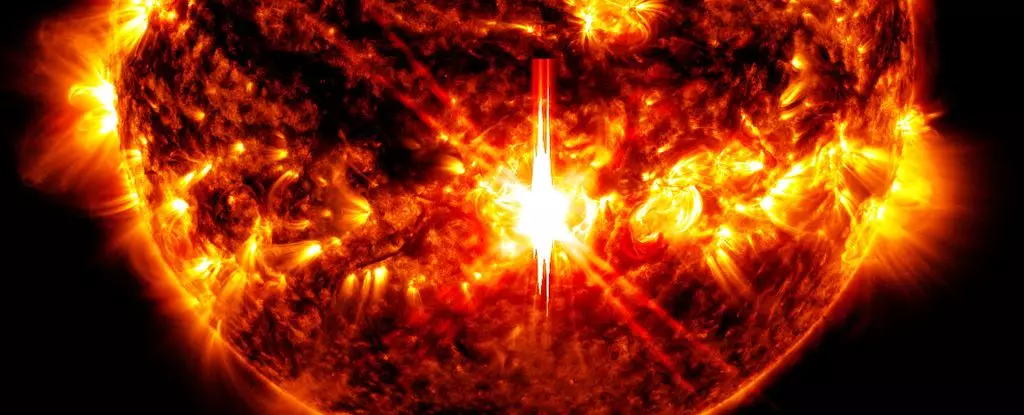In early October 2024, a remarkable event unfolded in our solar system that has captivated scientists and space enthusiasts alike. The Sun unleashed a powerful solar flare, recorded as an X9.0, marking the most intense flare witnessed in a span of seven years. This surge of activity not only enthralled observers on Earth but also underscored the dynamic and often unpredictable nature of solar phenomena. This article aims to delve deeper into the implications of this event, the causes behind such powerful flares, and the potential effects on our planet.
A solar flare is essentially an explosive release of energy on the Sun’s surface, resulting from the complex interplay of magnetic fields associated with sunspots. These eruptions can release vast amounts of energy, equivalent to millions of hydrogen bombs detonating simultaneously. The severity of a solar flare is classified into different categories, with X-class flares representing the most potent category. The recent X9.0 flare, which originated from sunspot region AR 3842, signifies a culmination of magnetic instability within the Sun’s surface.
Sunspots, temporary phenomena on the solar surface caused by concentrated magnetic fields, serve as the incubators for these flares. The recent surge in solar activity aligns with the peak of the Sun’s 11-year solar cycle, which has seen an increase in flares since early 2022. While most occurrences are minor, the notability of the X-class flares, particularly the recent events, provides an invaluable opportunity for researchers to understand solar behavior better.
The remarkable occurrence of the X9.0 flare can be attributed to the complex magnetic configuration within AR 3842, categorized as a Beta-Gamma-Delta sunspot region. In such regions, the mingling of magnetic polarities creates conditions ripe for energy bursts. As magnetic field lines in these areas tangle and snap, solar flares are generated, resulting in the expulsion of solar material and radiation into space. The X9.0 flare, following an earlier X7.1 flare from the same sunspot on October 1, demonstrates the potential for repeated, high-energy activity within a single sunspot region.
The combination of intense magnetic fields and rapid reconnection processes creates a highly volatile environment on the solar surface, propelling these stunning cosmic events. With ongoing solar activity, scientists remain vigilant, as further flares could emerge in the coming days.
Consequences for Earth
While Earth itself remains a safe distance from the harmful radiation emitted by solar flares, the associated coronal mass ejections (CMEs) have the potential for significant consequences. CMEs consist of large bubbles of solar gas and magnetism that can disrupt the geomagnetic environment on Earth when they collide with our planet’s magnetic field. The October 3 flare was particularly notable not only for its strength but also for the halo CME it produced, directed squarely at Earth.
As these solar particles journey through space, they can trigger geomagnetic storms upon reaching our atmosphere. The consequences of such storms can manifest in various forms, including fluctuations in power grids, disruptions in satellite communications and GPS systems, and even affecting airline routes that rely on precise navigation.
Auroras: The Beautiful Outcome
One of the more enchanting effects of solar flares and CMEs is the creation of auroras. As solar particles collide with the Earth’s atmosphere, they can create striking displays of colorful light in the sky, commonly known as the Northern and Southern Lights. The recent flares have elevated auroral activity, with the potential for auroras to be visible at lower latitudes than usual—extending down to approximately 50 degrees latitude in specific cases.
The magnificent colors of these auroras are a result of the ionization of atmospheric particles. When energized by solar interactions, these particles produce vibrant glows, akin to giant neon lights illuminating the night sky. Nature’s artistry, made possible by solar activity, drives both scientists and citizens alike to engage in skywatching activities during such heightened solar events.
The Future of Solar Observations
As we look ahead in the context of solar activity, the recent X-class flares represent a crucial reminder of the importance of continuous solar observations. The space weather community must remain vigilant for the possibility of future flares as we venture further into the solar cycle’s peak. Heightened solar activity can provide vital insights into the Sun’s complex behavior and its impact on our technological society.
The X9.0 flare of October 3 offers a fascinating glimpse into the forces at play on our Sun. From the intricacies of sunspot dynamics to the ethereal beauty of auroras, the events of recent weeks urge scientists and enthusiasts to pay closer attention to our celestial neighbor and the extraordinary phenomena it continues to unveil. As solar predictions unfold, they will undoubtedly enrich our understanding of the universe we inhabit.


Leave a Reply